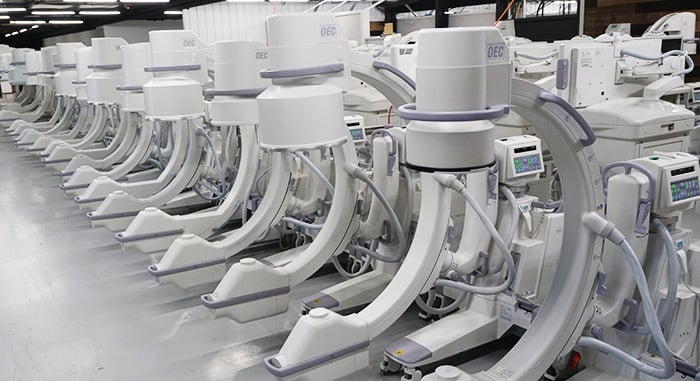
It's not news to anybody that space is money. The square footage at your center/clinic/practice comes at a price, so you try to use it as efficiently and effectively as you can. Because of this "economy of space", our team receives regular requests from users hoping to save space with a compact all-in-one C-arm; that is, a C-arm that eliminates the need for a monitor cart by mounting the monitor(s) on the C-arm itself.
The request makes perfect sense, and an all-in-one C-arm can definitely save you some space, but reaping the benefit of compact design comes with some trade-offs too. Let's break down the pros and cons of choosing an all-in-one C-arm and see what the options are.
The Pros and Cons of All-in-One C-Arms
If you're considering an all-in-one C-arm, here are the details you need to be aware of before you finalize a purchase.
Pros
There's no denying that an all-in-one design has a more compact footprint than a traditional C-arm configuration with a monitor cart. This footprint removes an element of clutter from your operating space.
Another benefit of choosing an all-in-one design is pricing. Compact systems almost always cost less than standard-sized systems of similar age and overall condition.
Cons
Trimming down the size of a C-arm system comes with a couple of big trade-offs. The first of these is limitations to positioning and angulation of the c-arm in the OR. With the monitor directly on top of the C-arm, the user is confined to a close proximity around the C-arm for proper viewing. The flexibility of wheeling a monitor cart wherever it's needed is lost.
The second trade-off of compact design is overall power. A typical generator power level for an all-in-one C-arm is 5kW or less. Compare that to the 15kW - 25kW range among standard-sized systems. All-in-one systems also use stationary anode tubes with lower heat capacities. If you need a system to accommodate large patients or cross lateral shots, you won't find that capability in a compact design.
Options
The all-in-one design concept hasn't been widely popular, particularly in the US. Because of this, there aren't many options available. OEC released the 7600 all-in-one in the late 90's, followed shortly by the Ziehm compact. Ziehm carried the torch for all-in-one over the next fifteen years or so, releasing the Ziehm Quantum (notorious for image case problems), Ziehm Solo, and Ziehm Solo FD. OEC recently released the OEC One, which is very similar to the Solo FD, but image intensifier-based. Ultimately, you can count legitimate options for a compact, all-in-one design on one hand.
The Takeaway
If you have a facility that's under space constraints, focuses on lighter tasks, and has a more moderate patient volume, an all-in-one design can be a good, space-saving fit for you.
On the other hand, over twenty years since the concept hit the market, there still hasn't been strong market traction for these models. That tells us that the typical user won't find the trade-off of power and flexibility for a little more space worthwhile.
Whichever way you may be leaning, our team is ready to help you match your needs and workflow to the best C-arm fit for you. Use the button below to start the conversation!

Chris Sharrock
Chris Sharrock is the Vice President of Healthcare Solutions at Block Imaging. Each day Chris sets out to provide the best equipment, parts, and service solutions for healthcare facilities across the world. Outside of work Chris enjoys playing in a band, and spending time at the lake with his family.






